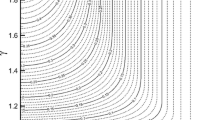Abstract
The distributions of velocity and their fluctuations, the steady wave of free surface and the presence of air bubbles can significantly influence the extent to which useful resistance measurements can be obtained from ship models in circulating water channels. This paper describes a. circulating water channel and experimental techniques which allowed accurate measurements of the resistance of small models and the extrapolation of the results to ship hulls.
Similar content being viewed by others
Abbreviations
- A AM :
-
midship section area of ship model
- B :
-
breadth of ship model
- C h :
-
block coefficient, ∇/(L pp · B · d)
- C p prismatic coefficient, ∇/(L pp · A M ):
-
C M
- midship section coefficient, A M /(B · d):
-
C r total resistance coefficient of ship model, R r /(1/2 ϱ V 2 S)
- C f :
-
frictional resistance coefficient of equivalent flat plate, R f /(/12 ϱ V 2 S)
- d :
-
draft of ship model
- Fn:
-
Froude number, V/\(\sqrt {L_{pp} \cdot g} \)
- F.P.:
-
fore perpendicular of ship model (leading edge of water plane of ship model)
- f w :
-
correlation function referred to wave resistance
- g :
-
gravity acceleration
- H :
-
depth of water in the working section
- H w :
-
height of the steady wave of free surface in the working section
- K :
-
form factor of ship model
- l :
-
distance from a flexible sheet to the leading edge of water plane of ship model (F.P.)
- L pp :
-
length between perpendicular of ship model
- Rn:
-
Rynolds number,(V· L pp )/v
- R l :
-
total resistance
- R 10 :
-
total resistance corrected to mean gradient of free surface in the working section
- R w :
-
wave resistance
- R r :
-
residual resistance
- R f :
-
frictional resistance of equivalent flat plate
- r t :
-
total resistance coefficient, R t /(ϱ V 2 V 2/3)
- r R :
-
residual resistance coefficient, R r /(ϱ V 2 V 2/3)
- r f :
-
frictional resistance coefficient of equivalent flat plate, R f /(g V 2 V 2/3)
- r w :
-
wave resistance coefficient, R w /(ϱ V 2 V 2/3)
- S :
-
wetted surface of ship model
- S u :
-
amplitude of the fluctuation of free surface in the working section
- T :
-
period of the fluctuation of free surface in the working section
- V :
-
mean velocity in the working section
- V′ :
-
flow velocity at an arbitrary position
- Δ :
-
displacement weight of ship model
- ∇:
-
displacement volume of ship model
- β :
-
correlation function referred to form factor
- 0 :
-
mean gradient of free surface in the working section
- λ:
-
wave length of steady wave of free surface in the working section
- ν:
-
kinematic viscosity
- λ :
-
wave elevation of free surface in the working section
- ϱ:
-
density
- L :
-
large ship model
- S :
-
small ship model
References
Froude. W. 1874: On experiments with H.M.S. Greyhound. Transact. Inst. Nav. Arch. 15, 36–73
Hanawa, T. et al. 1981: Study on the hull form with Catamaran stern — Applied to tanker/Bulk Carrier. J. Kansai Soc. Nav. Arch. 181,35–43
Hughes, G. 1954: Friction and form resistance in turbulent flow, and a proposed formulation for use in model and ship correlation. Transact. Inst. Nav. Arch. 96, 314–376
Kayo, Y.; Takekuma, K. 1981: On the free surface shear flow related to bow wave-breaking of full ship models. J. Soc. Nav. Arch. of Japan 149, 11–20
Kitazawa, T. et al. 1982: Increase in the propulsive efficiency of a ship by nozzle installed just in front of a propeller. J. Kansai Soc. Nav. Arch. 184, 73–78
Schoenherr, K. 1932: Resistance of plates. Transact. Soc. Nav. Arch. Marine Eng. 4, 209–313
SR 159, 1977: Study on the flow field about stern for the development of new economical ship hull form (in Japanese). Ship Building Res. Ass. Jpn. 273, 173–201
SR 159, 1978: Study on the flow field about stern for the development of new economical ship hull form (in Japanese). Ship Building Res. Ass. Jpn. 289, 76–108
SR 174, 1979: Study on the development of single-screw stern with the object of power-saving (in Japanese). Ship Building Res. Ass. Jpn. 320, 23–64
Takahei, T.; Tagori, T. 1975: Resistance test in circulating water channel (in Japanese). J. Kansai Soc. Nav. Arch. 159, 57–63
Takahei, T. et al. 1976: On the wave resistance of a ship on the stream of which velocity varies with depth. Intern. seminar on wave resistance. 1, 349–353
Tamura, K. 1972: Study on the blockage correction. J. Soc. Nav. Arch. Jpn. 131. 17–28
Author information
Authors and Affiliations
Rights and permissions
About this article
Cite this article
Tamashima, M., Matsui, S. & Ogura, M. Quantitative measurements with small models of ships in a circulating water channel. Experiments in Fluids 1, 135–142 (1983). https://doi.org/10.1007/BF00272012
Received:
Issue Date:
DOI: https://doi.org/10.1007/BF00272012




